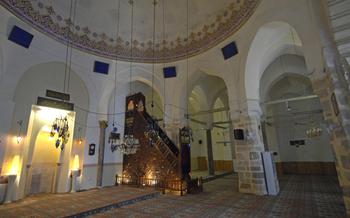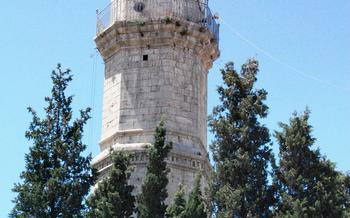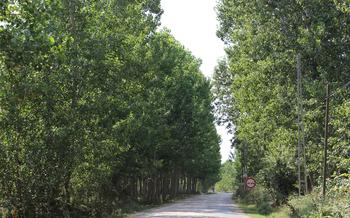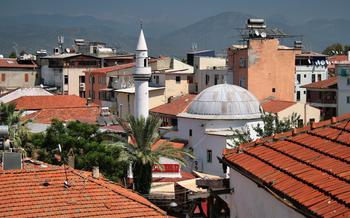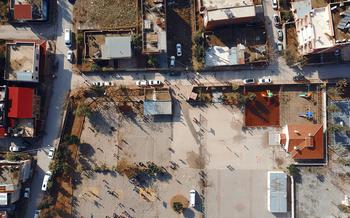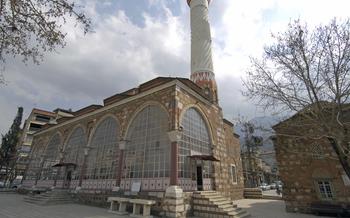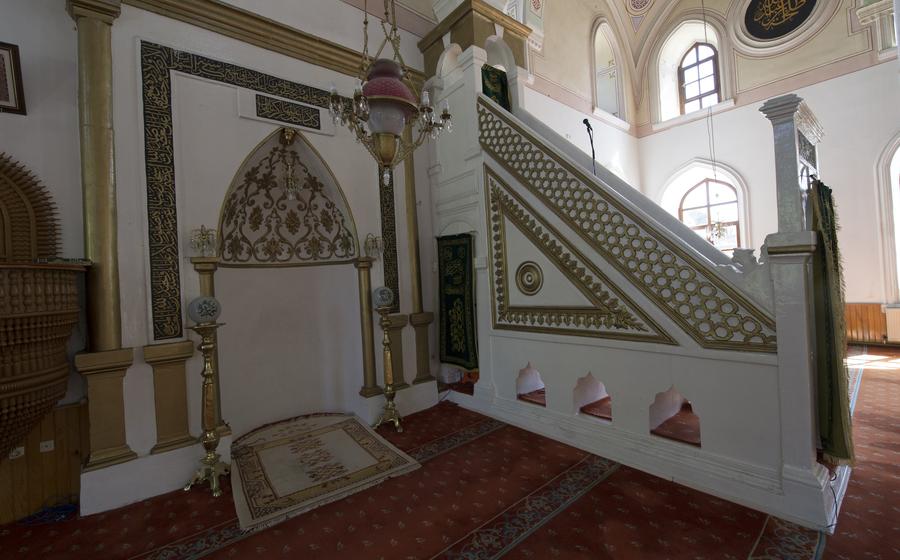
Kutlubey/Ulu Mosque
- History of the Kutlubey/Ulu Mosque
- Architectural Features
- Kutlubey/Ulu Mosque's Location
- Visiting Hours and Etiquette
- Exploring the Mosque's Interior
- Prayer Experience
- Local Cultural Significance
- Festivals and Events
- Photographing the Mosque
- Local Crafts and Souvenirs
- Local Cuisine
- Language and Communication:
- Safety and Security:
- Respecting Local Customs:
- Insider Tip: Uncovering the Hidden Courtyard Garden
History of the Kutlubey/Ulu Mosque
The Kutlubey/Ulu Mosque, an architectural masterpiece in Isparta, Turkey, stands as a testament to the region's rich religious and cultural history. Built in the 15th century during the Anatolian Beyliks period, the mosque holds immense historical significance. Its construction was commissioned by Kutlu Bey, the ruler of the Beylik of Teke, who sought to create a grand and awe-inspiring place of worship for his people.
The mosque's construction reflects the architectural style prevalent during the period, characterized by intricate stonework, elegant domes, and towering minarets. Its design showcases a fusion of Seljuk and Ottoman influences, blending traditional Islamic elements with local architectural traditions. The Kutlubey/Ulu Mosque has played a pivotal role in the region's religious and cultural landscape, serving as a center for communal prayers, religious gatherings, and Islamic education for centuries.
Architectural Features
The Kutlubey/Ulu Mosque stands as an exceptional example of Islamic architecture, showcasing a fusion of Seljuk and Ottoman styles that has withstood the test of time. Its striking exterior is adorned with intricate stone carvings, geometric patterns, and impressive calligraphy that reflect the artistic prowess of the era. The mosque's rectangular shape is complemented by a single dome and four minarets, each adorned with unique designs and providing a harmonious balance to the overall structure.
Upon entering the mosque, visitors are greeted by a spacious interior that exudes a sense of tranquility and awe. The main prayer hall is supported by a series of graceful columns and arches, creating a forest-like effect that draws the eye upwards. The mihrab, the niche indicating the direction of Mecca, is intricately carved with verses from the Quran and serves as a focal point for worshipers. The minbar, or pulpit, is an exquisite example of craftsmanship, featuring delicate carvings and intricate inlay work that showcase the skill and dedication of the artisans who created it.
The mosque's courtyard provides a serene and inviting space for contemplation and relaxation. Surrounded by arched walkways and adorned with a central fountain, the courtyard offers a tranquil retreat from the bustling city outside. The mosque's ablution fountain, with its multiple taps and intricate carvings, is not only functional but also a testament to the attention to detail that went into every aspect of the mosque's design.
Kutlubey/Ulu Mosque's Location
Situated in the heart of Isparta, the Kutlubey/Ulu Mosque stands as a prominent landmark within the city's urban fabric. Its strategic location makes it easily accessible to both residents and visitors, offering a convenient and immersive experience.
To reach the mosque, one can take advantage of the well-connected public transportation system. Several bus stops are located within walking distance, providing seamless connectivity from various parts of the city. Alternatively, taxis are readily available, offering a comfortable and direct route to the mosque's doorstep.
The Kutlubey/Ulu Mosque's proximity to other notable attractions further enhances its appeal. The Isparta Museum, a treasure trove of local history and culture, is just a short stroll away, inviting visitors to delve deeper into the region's rich heritage. The vibrant Isparta Bazaar, with its colorful stalls and authentic Turkish delights, is also within easy reach, providing an opportunity to immerse oneself in the local traditions and flavors.
Visiting Hours and Etiquette
The Kutlubey/Ulu Mosque welcomes visitors during specific hours. It is essential to respect these timings and any restrictions imposed to ensure the smooth functioning of religious activities. Proper attire is expected, with modest clothing covering the shoulders and knees for both men and women. Visitors should be mindful of their behavior, maintaining a respectful and quiet demeanor within the mosque's sacred space. Shoes must be removed before entering the prayer hall, and visitors are encouraged to maintain a respectful distance from worshippers engaged in prayer. By observing these simple guidelines, visitors can contribute to the peaceful and harmonious atmosphere of this revered site.
Exploring the Mosque's Interior
Upon stepping into the Kutlubey/Ulu Mosque, visitors are greeted by a vast and awe-inspiring main prayer hall. The spacious interior is adorned with intricate carvings, colorful tiles, and elegant calligraphy, creating a harmonious blend of art and spirituality. The high ceiling, supported by rows of slender columns, adds to the sense of grandeur and spaciousness.
The focal point of the prayer hall is the mihrab, a beautifully decorated niche that indicates the direction of Mecca. Intricate carvings and colorful tiles surround the mihrab, creating a mesmerizing visual display. To the right of the mihrab stands the minbar, a raised platform from which the imam delivers sermons during prayers. The minbar is meticulously crafted with intricate woodwork and inlaid with mother-of-pearl, showcasing the exceptional craftsmanship of the era.
Beyond the main prayer hall, visitors can explore the mosque's serene courtyard. Surrounded by graceful arches and columns, the courtyard provides a tranquil oasis amidst the bustling city. The courtyard features a central fountain, where visitors can pause and reflect, surrounded by the mosque's serene ambiance.
Prayer Experience
The Kutlubey/Ulu Mosque primarily serves as a place of worship for Muslims. It offers a serene and sacred environment for individuals to connect with their faith and engage in spiritual practices. Attending prayers at the mosque is a unique and immersive experience that allows visitors to observe the local traditions and customs associated with Islamic worship.
The mosque's main prayer hall is spacious and adorned with intricate designs and calligraphy. During prayer times, the hall fills with devout worshippers who gather to perform their daily prayers in unison. The atmosphere is tranquil and reverent, as worshippers immerse themselves in their spiritual devotion.
Visitors are welcome to observe the prayers from a designated area without disrupting the worshippers. It is important to maintain respectful silence and avoid any actions that may be distracting or disrespectful. Observing the local customs and traditions during prayers, such as removing shoes and performing ablutions before entering the prayer hall, is highly recommended.
By attending prayers at the Kutlubey/Ulu Mosque, visitors gain a deeper understanding of the religious practices and customs of the local community. It is an opportunity to witness the vibrant spiritual heritage of Isparta and experience the profound sense of devotion that permeates the mosque's atmosphere.
Local Cultural Significance
The Kutlubey/Ulu Mosque holds immense local cultural significance, deeply intertwined with the identity and heritage of Isparta. For centuries, it has served as a spiritual and communal center, fostering a sense of belonging among the Muslim community. The mosque's architectural grandeur and rich history have made it a symbol of Islamic heritage in the region, attracting visitors from across Turkey and beyond.
The mosque's profound impact on the city's cultural landscape is evident in its role as a gathering place for religious observances, community events, and celebrations. During festivals and holidays, the mosque becomes a hub of activity, adorned with vibrant decorations and resonating with the sounds of prayers, music, and laughter. These gatherings not only strengthen the bonds within the community but also showcase the vibrant cultural traditions and customs of Isparta.
Festivals and Events
The Kutlubey/Ulu Mosque, deeply embedded in the cultural fabric of Isparta, plays host to various festivals and events that showcase the city's rich Islamic heritage. One of the most prominent is the annual Mevlid-i Nebi, a celebration commemorating the birth of Prophet Muhammad. During this time, the mosque transforms into a hub of festivities, with colorful decorations adorning its exterior and interior. Devotees gather to recite prayers, listen to sermons, and engage in communal feasts. The atmosphere is electric, filled with the sounds of devotional music, laughter, and the camaraderie of the local community. Participation in these events offers visitors a unique opportunity to immerse themselves in the spiritual and cultural essence of Isparta.
Photographing the Mosque
When visiting the Kutlubey/Ulu Mosque, photography enthusiasts may wish to capture the mosque's stunning beauty and intricate details. While photography is generally permitted within the mosque, it is essential to respect the sanctity of the site and follow the guidelines to ensure a respectful and ethical approach.
Before taking any photos, seek permission from the mosque's caretaker or a local guide. This shows respect for the religious significance of the site and ensures that you are not causing any disruptions to ongoing prayers or activities.
When photographing inside the mosque, avoid using flash or bright lights. These can be disruptive and disrespectful to those engaged in prayer or contemplation. Use natural light or low-light settings on your camera to capture the mosque's interior without disturbing the atmosphere.
Be mindful of other visitors and avoid obstructing their views or blocking their path while taking photos. Respect the privacy of individuals by refraining from taking close-ups or portraits without their consent.
Remember that the mosque is an active place of worship, and it is essential to be respectful of the religious sentiments of visitors and worshippers. Avoid taking photos that may be considered inappropriate or offensive.
By following these guidelines, you can capture the beauty of the Kutlubey/Ulu Mosque while showing respect for its religious significance and preserving the sanctity of the site.
Local Crafts and Souvenirs
As you stroll around the Kutlubey/Ulu Mosque, take the opportunity to explore the nearby shops and stalls selling local crafts and souvenirs. These stalls are a treasure trove of unique handicrafts and mementos that reflect the rich cultural heritage of the region. From intricate carpets and textiles to hand-painted ceramics and jewelry, there's something for every taste and budget.
Support the local artisans by purchasing their beautiful creations. Each item is a testament to their skill and dedication, and your purchase helps preserve the traditional crafts that have been passed down for generations. Whether you choose a colorful rug, a delicate piece of jewelry, or a hand-painted ceramic, your souvenir will serve as a cherished reminder of your visit to the Kutlubey/Ulu Mosque and the vibrant city of Isparta.
Local Cuisine
When exploring the area surrounding the Kutlubey/Ulu Mosque, visitors have the opportunity to indulge in the delectable flavors of traditional Turkish cuisine. The streets near the mosque are dotted with an assortment of eateries, from modest cafes to charming restaurants, each offering a tantalizing array of dishes.
Partake in the local tradition of "pide," a delectable boat-shaped flatbread topped with an assortment of savory ingredients. Savor the fragrant aroma of freshly baked "simit," a circular bread encrusted with sesame seeds, perfect for a quick snack.
For a truly immersive culinary experience, venture into one of the traditional Turkish restaurants and order a hearty plate of "kebab," succulent grilled meat served with aromatic rice and crisp vegetables. Alternatively, try "mantı," delicate dumplings filled with minced lamb or beef, served in a rich yogurt sauce.
Don't forget to end your meal on a sweet note with a taste of "künefe," a delightful pastry filled with shredded phyllo dough, sweet cheese, and syrup, or indulge in the rich flavors of "lokum," also known as Turkish delight, a confection made from sugar, starch, and flavored with rosewater or other essences.
As you savor the local delicacies, embrace the warmth and hospitality of the Turkish people, who take pride in sharing their culinary treasures with visitors. Immerse yourself in the vibrant food culture of Isparta, where every bite tells a story of tradition, flavor, and the region's rich heritage.
Language and Communication:
The primary language spoken in Isparta, including the area surrounding the Kutlubey/Ulu Mosque, is Turkish. While English is understood and spoken to some extent, especially in tourist areas, it is helpful to have a basic understanding of Turkish phrases or gestures to facilitate communication. Locals are generally friendly and welcoming, and they appreciate visitors who make an effort to engage with them in their own language. When asking for directions or information, it is polite to start with a greeting, such as "Merhaba" (Hello) or "İyi günler" (Good day). Useful phrases like "Teşekkür ederim" (Thank you) and "Lütfen" (Please) can go a long way in showing respect and appreciation. With a smile and a willingness to communicate, visitors can easily connect with the locals and enhance their overall experience in Isparta.
Safety and Security:
Visiting the Kutlubey/Ulu Mosque and exploring the surrounding area is generally safe. However, it's important to exercise caution and take necessary precautions to ensure your personal safety and belongings. Here are a few tips to keep in mind:
-
Be aware of your surroundings: Remain vigilant and pay attention to people and activities around you.
-
Valuables: Avoid carrying excessive cash or valuables. Keep your belongings close and secure.
-
Dress appropriately: Respect local customs by dressing modestly, especially when visiting the mosque.
-
Photography: Ask permission before taking photos of people or sensitive areas. Be mindful of privacy and avoid causing offense.
-
Local laws: Familiarize yourself with local laws and regulations. Respect the customs and traditions of the region.
-
Emergencies: In case of emergencies, dial 112 for assistance. The number connects you to the police, ambulance, or fire department.
Respecting Local Customs:
As a visitor to the Kutlubey/Ulu Mosque, it is essential to be mindful of local customs and norms to ensure a respectful and enriching experience. Refrain from entering the mosque wearing revealing or immodest clothing. Instead, dress conservatively to show respect for the religious significance of the site. When inside the mosque, maintain a quiet demeanor, avoid loud conversations, and refrain from pointing your feet towards the qibla (the direction of prayer). Remember to remove your shoes before entering the prayer hall and place them neatly on the designated shelves. Respect the privacy of worshippers by avoiding taking photos or videos without their permission. Embrace the opportunity to interact with locals with a smile and a friendly greeting. Using simple Turkish phrases like "Merhaba" (hello) or "Teşekkür ederim" (thank you) demonstrates your respect for their culture and can lead to meaningful encounters. By observing these customs, you can immerse yourself in the local culture and contribute to a positive and harmonious environment at the Kutlubey/Ulu Mosque.
Insider Tip: Uncovering the Hidden Courtyard Garden
Beyond the mosque's main prayer hall lies a hidden treasure—a serene courtyard garden that offers a tranquil escape from the bustling city. This secluded oasis, tucked away from the main thoroughfares, is a sanctuary of peace and tranquility. Visitors can wander amidst the lush greenery, admire the vibrant flowers, and soak in the calming atmosphere. The garden provides a unique perspective of the mosque's architecture, with its towering minarets framing the serene landscape. It's the perfect place to pause, reflect, and appreciate the beauty of Islamic art and nature in harmony.
